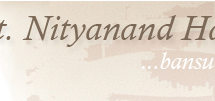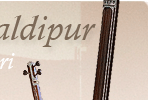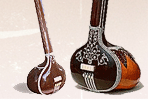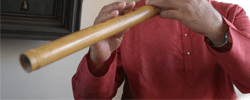





|
|



"True Voice of the Flute"
Barring a few exceptions, one's teacher becomes the index of a musician's competence and caliber.
That is why one of the first queries one makes about an unknown artiste invariably is whom has he or she learnt from? Except for a major upheaval or drift in his artistic temperament a shisha continues to hold a mirror to his guru and reflect his attributes.
A few days ago, the Delhi Music Circle in collaboration with India International Centre put up a flute recital by Nityanand Haldipur. What attracted me to the programme was the names of his teachers, Devendra Murdeshwar and Annapurna Devi. Earlier Nityanand was initiated to the art of flute playing by his father, Niranjan Haldipur, who was himself a disciple of Pannalal Ghosh. Nityanand also had the benefit of learning from the eminent vocalist, Pundit Chidanand Nagarkar. Thus by a lucky accident, Nityanand imbibed one and the same musical culture from his various teachers.
His recital did not belie my expectations. In fact, it was after a long time - perhaps more than two decades since Devendra Murdeshwar left Delhi and settled down in Mumbai - that I heard the 'true voice of the flute'.
Public memory being proverbially short and also because new modes and fashions crop up in no time and hold centrestage, very few people of the new generation know of the late Pannalal Ghosh, father of the hindustani bass flute. Before him the flute was deemed as an essentially pastoral instrument, a companion to the shepherd rearing sheep on the slopes of a hill and sending the hill and the vale reverberating with his small flute with its in-built simplicity and sensuousness. It was the very breath of folk music.
The emergence of the flute on the classical music scene and its measuring up to its exacting demands was entirely due to the efforts of Pannalal Ghosh who experimented with many mediums and sizes to evolve the modern bamboo flute. Not the less valuable as well as contributing to the glory of the humble wood-wind instrument was the superior musicianship of Panna Babu, a staunch classicist who would give nothing away to preserve the unalloyed purity of a raga and the dignity and grandeur of its delineation. Those who had the good fortune of listening to his full-length renderings of serious classical themes like Puriya, Shree, Darbari Kanhra, Mian Ki Malhar, Lalit and the like always pondered how he had managed to evolve every nuance, embellishment and effect known to classical music on the simple bamboo reed. He was able to accord to the alaap the large proportions, depth and dignity, the severe restraint and discipline of Khayal and Dhrupad. No ungentle, out of turn note or intonation dared enter his delineation and every exposition used to be an edifice of aesthetical and architectural beauty. And now after him though the flute has grown immensely popular, the qualities of dignity, restraint, authentic and accurate portrayal of a raga have become hostages to popularity and cheap public approval.
The flute does not speak in its own native language. It prefers to masquerade in feathers borrowed from the plucked instruments, the sitar and sarod, aping their staccato, jerky insinuations, jhala and what not! Its innocent, 'moon sheen' charm has been done to death by the continuously overblown and accented notes and rhythm-oriented utterance, which alone provide a punch to today's audiences.
However, three cheers to Nityanand Haldipur who brings a breath of freshness and originality and restores the true utterance to the flute in the midst of the prevailing depravity. The golden rule is, what the human voice does, the flute can and should do. Though in a small way, Haldipur brought back memories of good old days when flute had a stately gait and demeanor as opposed to the "autorickshaw frolics and flippancy" characterising its playing today.
Haldipur's smooth, even blowing (in place of uneven spurts of breath for effect and rhythmic accentuation), finger technique and movement, an array of subtle grace-notes or "Kana swaras" and arching terminal notes produced with a rounded lip, all conjured up the old romance and lyricism of this loved instrument, made divine by Krishna, also called Murlidhar.
Spurning chivalry in favour of practical wisdom, Haldipur chose to render the simple but evergreen Yaman. The common Yaman and Bihag find greater flavour with the well grounded musicians than with those of deficient training who prefer to show off even in the matter of choosing a raga. The two ragas were great favorites with his guru and even dadaguru. No doubt these all-sharp notes ragas assure a more buxom tone in a wind instrument than melodies employing semitones. Believe it or not, though Nishada and Gandhar happen to be the vital Vadi and Samvadi notes of Yaman, the Teevra Madhyama plays no less significant a role on the health and atmosphere of Yaman.
In a sense, the treatment of this note is symptomatic of a musician's fine grooming. Of this, Nityanand furnished sufficient proof. The Madhyama received the deserved attention through multiple glimpses prior to the vital Pancham coming into full view. Yet his repertoire did not include the placid Ma Ri Ga. Happily the recital had no place for gimmicks of tone or blowing.
The latter flowed in a gentle stream that had no eddies. The tone as a result was edgeless and unflustered. In deference to the character of the instrument, the recital was not marred by excessive staccato except of course in the closing jhala. Frequent listeners must have found a good riddance from the prevailing obsession for Tihais at every step and sequence as well as for the talas of seven and ten beats. There was no extraneous element nor spur-of-the-moment experimentation to vitiate the purity of the raga which flowered unencumbered on the two pedestals of Ri Ga Ma Pa, Ri Ga and the accurate Ni Dha Pa. One does not remember having encountered any off-key note anywhere in the recital. In fact the pervasive and precise tune of the Gandhar, Pancham and Nishada permeated into one's being involuntarily.
Haldipur's systematic, note by note swara vistar, though not as expansive and detailed, still brought back memories of the era of Pannalal Ghosh. The gradual unfoldment of a raga used to be treated as 'ritual of badat' by Ghosh. To come across an inkling of the same in Haldipur's slow elaboration of his theme, gave one a good feeling.
The casket of the raga was not opened all at once. One liked the introduction of the Dhaiwata, a faint glimpse at first followed by a frontal dig at it. Use of the laya did not lose sight of the soft nature of the instrument. A swift Tana soaring to the Tar Pancham displayed the commendable control over sur, tone and blowing the artiste enjoyed even in the peak pitches. There is little doubt that Nityanand Haldipur has a sensitive, feeling heart. It has much to communicate. Emotionally significant tones and figures do not fail to fire his imagination.
Prakash Wadhera - the Hindu 28.11.97
[Back]
HOME | REVIEWS | CDs| INTERVIEWS | DISCOGRAPHY | BANSURI | CONTACT ME